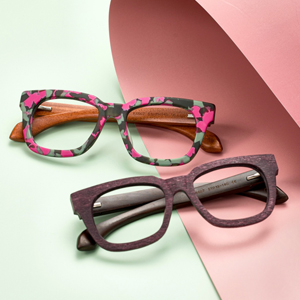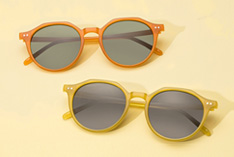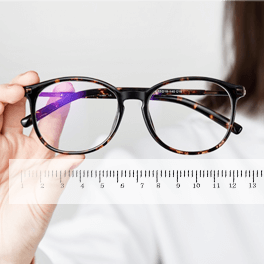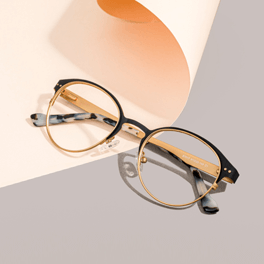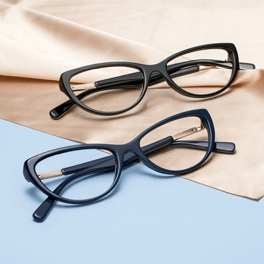FAQ
Quick Links
Lenses
The lenses type are divided by glasses functions and lens index.
For glasses functions, we offer single vision lenses, bifocal lenses, progressive lenses, driving lenses, blue-light blocking lenses, and lenses for sunglasses.
For lens index, we offer 1.50 CR-39 Plastic, 1.56 Mid-Index Plastic, 1.60 Aspheric High-Index, 1.60 Superflex MR-8, 1.67 Aspheric High-Index, 1.71 Aspheric High-Index, 1.74 Aspheric High-Index.
As for the coating at Zinff, we offer Scratch-Resistant Coating for free to all our customers. And you can also pay to add other coatings to your lenses. We have Anti-Reflective Coating, UV Coating, Super Hydrophobic Coating.
It depends on how strong your prescription is. Based on the glasses' comfort and thickness, we recommend the lens index for you in the ordering process already. If you have no idea how to pick out the best lens for your prescription. Just go with our recommendations!
You can also check the recommendation table below.

Different index lenses at Zinff are made of patented materials.
1.56 mid-index lenses are made of KOC 55 developed by KOC(Korea)/Chungho(Korea).
1.60 hi-index lenses are made of KR 60 developed by KOC(Korea)/Chungho(Korea).
1.60 superflex lenses are made of MR-8 developed by Mitsui(Japan).
1.67 hi-index lenses are made of MR-7 developed by Mitsui(Japan).
1.71 hi-index lenses are made of KR 70 developed by KOC(Korea)/Chungho(Korea).
1.74 hi-index lenses are made of MR-7 developed by Mitsui(Japan).
1.50 index lenses are made of CR-39 plastic developed by PPG Industries.
Yes, we offer frames only. You can leave a message with your requirements in the message box on the checkout page.
Please kindly note that all frames will come with decorative clear lenses to avoid the glasses deforming in transit.
Yes, we offer high-quality blue-light blocking lenses. We have 1.55 mid-index, 1.56 mid-index, 1.60 hi-index, 1.67 hi-index and 1.71 hi-index blue-light blocking lenses. You can select different lens index to suit your prescription.
*Click here to know more about Zinff blue-light blocking glasses.
Yes, we have progressive lenses and bifocal lenses. Our progressive glasses have patented manufacturing technology. We also offer various lens index for progressives and bifocals. It can better suit your prescription.
*If you are trying bifocals and progressive glasses for the first time, clik here to know how to use/adjust to progressive&bifocal.
If you are trying new progressives or bifocals, you may have to learn how progressive and bifocal lenses work.
Bifocals have two fields of vision: the upper for distance and the lower for up close. There is a visible line across the middle that divides the two corrections.
Progressives have a gradual or progressive change in vision in different parts of the lens, so there's no visible line on the lenses.
Progressive lenses have three fields of vision and tend to be blurry on the sides. You see far away through the upper lens and up close through the lower. The intermediate-range is used to see your laptop or something in the range of 20 inches (50 cm) to 40 inches (100cm) away from your eyes.
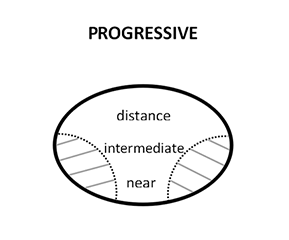
HOW TO USE BIFOCALS AND PROGRESSIVES
1.When you walk, look straight ahead, not down at your feet. Also, work on pointing your nose in the direction you want to look, not just looking left or right with your eyes. (You cannot see clearly through the peripheral lenses of progressives.)
2.When you read, hold the items down and about 16 inches away from your eyes. Look through the bottom of your lenses. (the bottom is for reading)
3.Don't move your eyes or head while you read. Move the page or paper instead.
4.Set your computer screen just below eye level. You can adjust your desk or chair.
For bifocal wearers, you need to get used to the different strength of the lens. You may feel a 'jump image' when first wearing bifocals because of that.
For progressive wearers, all you need is to practice how to focus your vision through different parts of the lenses.
No matter bifocals or progressive lenses, once you get it, it will be second nature, and you'll wonder why you ever tried them in the first place. Most people never go back to two or three single vision glasses.
Besides the convenience of one glasses, you'll likely feel like you have recaptured your natural vision at long distance and reading.
You can also try bifocal/progressive sunglasses after you get used to them. It will give you a totally different feeling.
Yes, we offer prism correction lenses. For now, you can only leave a message with your prism requirement when you place the order on our site. Also, the price difference of prism lens will be charged.
We provide all our customers with aspherical lenses except for a few custom lenses, such as prism correction lenses.
We offer various lens colors to meet your needs. We have tinted color, mirrored color.
For tinted lenses, dark colors are 80% tinted, and light colors are 20% tinted.
*Click here to see more about polarized sunglasses.
*Click here to check out Zinff Top Sunglasses Picks for you.
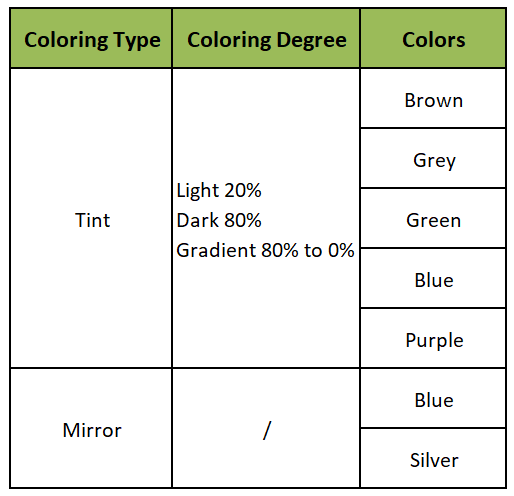
Yes, it is called Photochromic/Transitions® Photochromic on our site. It will turn dark when exposed to UV rays. The degree of the lens color is decided by how strong the UV rays are. And it will be back to clear lenses when you go inside the door.
The vision fields of the lens are different. The advanced progressive glasses have a wider vision area than the standard ones. Also, you can quickly get used to the advanced ones than the standard ones.
Photochromic is Zinff homemade brand. It costs less than the Transitions® brand. It will turn dark quickly than Transitions®.
Transitions® is produced by Essilor. It will automatically turn dark when exposed to UV rays. It will be darker than Photochromic.
Tint and Polarized lenses are permanent coloring. But Photochromic lenses will turn dark only when exposed to UV rays.
Polarized lenses are more suitable for driving. They can better reduce the glare and protect your eyes from UV rays.
*Click here to see more about polarized sunglasses.
*Click here to check out Zinff Top Sunglasses Picks for you.
The lenses cannot be removed yourself if you have a semi-rimless frame with a nylon fishing line.
Use an eyeglasses screwdriver and follow the steps below, you can easily remove the lenses. Don't forget to wash your hands with a cleaning solution first.
For Plastic Frame
Step 1: Double-check if there are any small screws on the back of the lenses and the frame sides holding the lenses in place. The lens screws are not the same as the ones that hold the arms on. Not all plastic frames have screws.
Step 2: Remove the lens screws, if present, using the eyeglass screwdriver to turn the screws counterclockwise. It may take a bit of effort, especially if this is your first time to remove the screws. Set the screws aside in a safe place.
Step 3: If your room temperature is very low, you may need to warm your glasses frame up a little bit first. Run the front of your glasses frame under warm water (90-100℉/30-37℃). Do not use hot water because overheating will get your lens and frame damaged.
Step 4: Dry your glasses with Zinff microfiber cloth and wrap the lens with it when removing the lenses. Let's start popping out the lenses one by one!
Grasp the left side of the frame in your left hand with the lenses facing downward. Put your left thumb against the right side of the bridge (in case you break the frame from the bridge).
Hold the right side of the frame in your right hand with your right thumb against the top center of the back of the lenses. Push firmly to pop the right lens out with your right thumb. Do not force the lens out.
After removing the right lens, put your hands and thumbs in the opposite positions to remove the left lens.
For Metal Frame
Step 1: Locate the small screws holding the lenses. The location of the screws depends on the style of your frame. First, check on the inside of your frame to see if there are two screws on the nose bridge. If not, look on the sides of your frames underneath the arm hinges for the screw. If you still can't find screws there, check along the bottom rim around your lenses to see if the screws are hidden there.
Step 2: Remove the lens screws, if present, using the eyeglass screwdriver to turn the screws counterclockwise. This may take a bit of effort, especially if this is the first time the screws have been removed. Set the screws aside in a safe place.
Step 3: Wrap the lenses with Zinff microfiber cloth, so you don't get fingerprints on them. Remove the lenses one by one.
Grasp the left side of the frame in your left hand with the lenses facing downward. Put your left thumb against the right side of the bridge (in case you break the frame from the bridge).
Hold the right side of the frame in your right hand with your right thumb in the top center of the back of the lenses. Push firmly to pop the right lens out with your right thumb. Do not force the lens out.
After removing the right lens, put your hands and thumbs in the opposite positions to remove the left lens.
Step 4: After you remove all the lenses from the frame, don't forget to install the screws back to your frame.
Blue light is all around us. It can be found from natural sunlight, LED light bulbs, television screens, smartphones & tablets, and computers.
Blue light can permanently damage our eyes. Blue-light blocking glasses can effectively protect your eyes from blue light from everywhere. So wearing blue-light blockers is a good idea no matter you are reading, walking, or driving.
Blu light blocking glasses can also help reduce digital eye strain. You may not notice you are experiencing eye strain sometimes, especially if you have good eyesight. But as long as you use smartphones, tablets, computers, and televisions, you'll need a pair of blue light blockers.
Try blue light blocking glasses especially when you have to work in front of the computer all day long, you will never regret buying them.
*Click here to know more about Zinff blue-light blocking glasses.
There are little markings on the lenses to allow the optometrist/dispensing optician to 'mark up' the lenses to check positioning. The numbers may be visible on bifocal lenses. Bifocals require different positioning for different visions. But the number may not noticeable on the progressive lenses. Only a couple of types of lens are marked in this way, and others are safety glasses.

